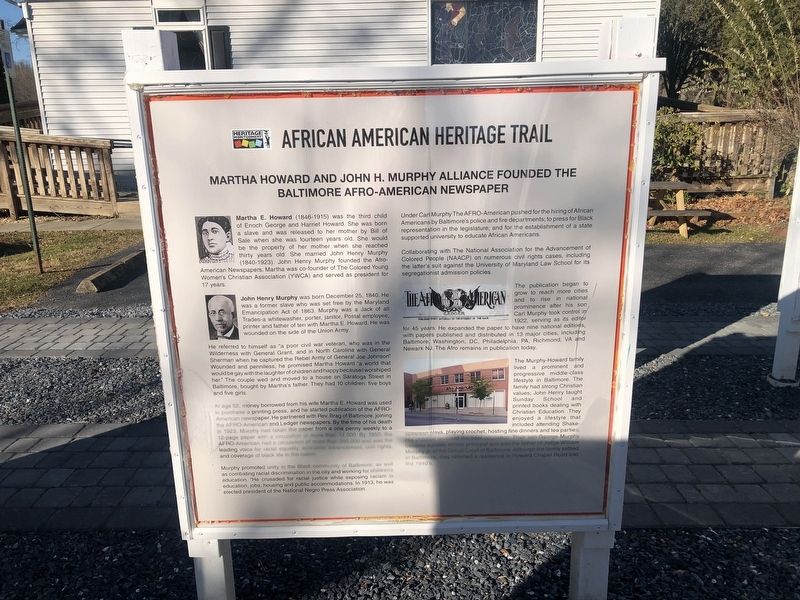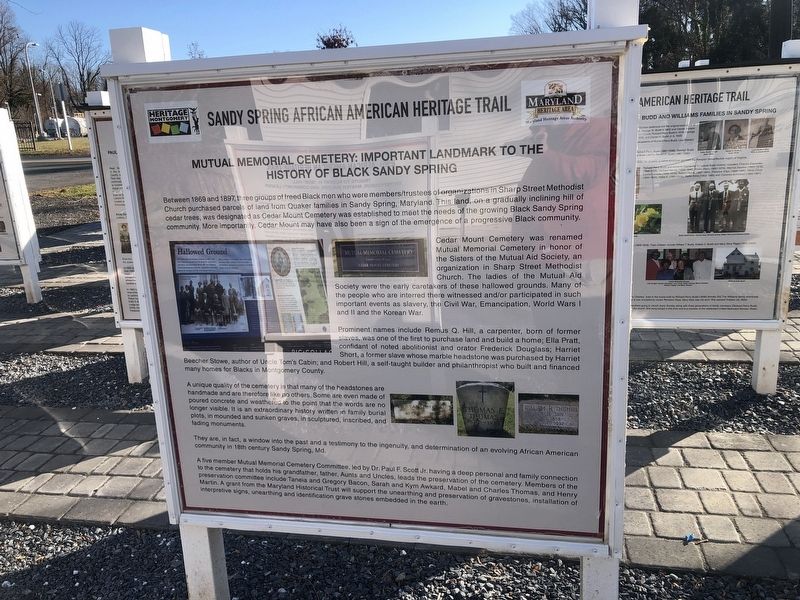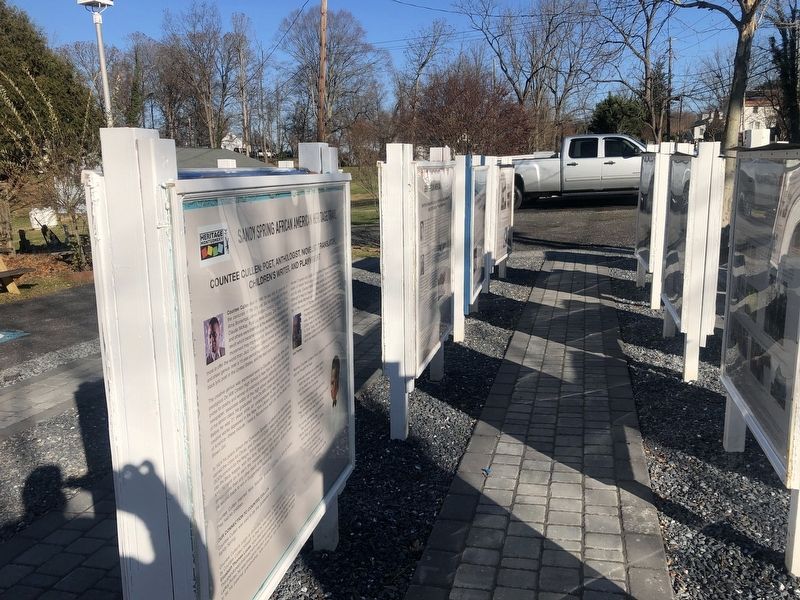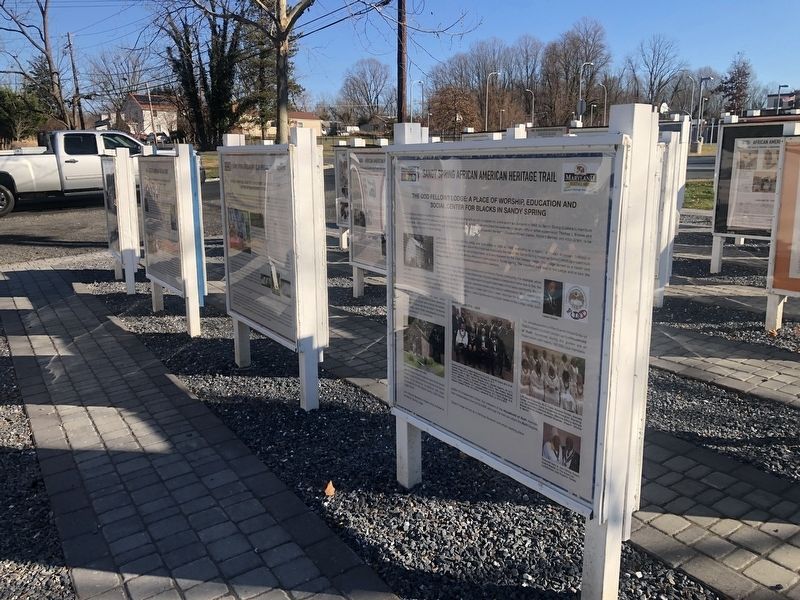Sandy Spring in Montgomery County, Maryland — The American Northeast (Mid-Atlantic)
Martha Howard and John H. Murphy Alliance / Mutual Memorial Cemetery
Sandy Spring African American Heritage Trail
— [Sandy Spring Slave Museum & African Art Gallery] —

Photographed By Devry Becker Jones (CC0), December 12, 2021
1. Martha Howard and John H. Murphy Alliance side of the marker
Martha Howard and John H. Murphy Alliance Founded the Baltimore Afro-American Newspaper
Martha E. Howard (1846-1915) was the third child of Enoch George and Harriet Howard. She was born a slave and was released to her mother by Bill of Sale when she was fourteen years old. She would be the property of her mother when she reached thirty years old. She married John Henry Murphy (1840-1923). John Henry Murphy founded the Afro-American Newspapers. Martha was co-founder of The Colored Young Women's Christian Association (YWCA) and served as president for 17 years.
John Henry Murphy was born December 25, 1840. He was a former slave who was set free by the Maryland Emancipation Act of 1863. Murphy was a Jack of all Trades-a whitewasher, porter, janitor, Postal employee, printer and father of ten with Martha E. Howard. He was wounded on the side of the Union Army.
He referred to himself as "a poor civil war veteran, who was in the Wilderness with General Grant, and in North Carolina with General Sherman when he captured the Rebel Army of General Joe Johnson". Wounded and penniless, he promised Martha Howard "a world that would be gay with the laughter of children and happy because I worshiped her." The couple wed and moved to a house on Saratoga Street in Baltimore, brought by Martha's father. They had 10 children: five boys and five girls.
At age 52, money borrowed from his wife Martha E. Howard was used to purchase a printing press, and he started publication of the Afro-American newspaper. He partnered with Rev. Brag of Baltimore, joining the Afro-American and Ledger newspapers. By the time of his death in 1923, Murphy had take n the paper from a one penny weekly to a 12-page paper with a circulation of more than 14,000. By 1950, the Afro-American had a circulation of more than 200,000 and was the leading voice for racial equality, economic advancement, civil rights, and coverage of black life in the nation.
Murphy promoted unity in the Black community of Baltimore, as well as combating racial discrimination in the city and working for children's education. "He crusaded for racial justice while exposing racism in education, jobs, housing and public accommodations. In 1913, he was elected president of the National Negro Press Association.
Under Carl Murphy The Afro-American pushed for the hiring of African Americans by Baltimore's police and fire departments; to press for Black representation in the legislature; and for the establishment of a state supported university to educate African Americans.
Collaborating with The National Association for the Advancement of Colored People (NAACP)

Photographed By Devry Becker Jones (CC0), December 12, 2021
2. Mutual Memorial Cemetery side of the marker
The publication began to grow to reach more cities and to rise in national prominence after his son Carl Murphy took control in 1922, serving as its editor for 45 years. He expanded the paper to have nine national editions, with papers published and distributed in 13 major cities, including Baltimore, Washington DC, Philadelphia, PA, Richmond, VA and Newark NJ. The Afro remains in publication today.
The Murphy-Howard family lived a prominent and progressive middle-class lifestyle in Baltimore. The family had strong Christian values; John Henry taught Sunday School and printed books dealing with Christian Education. They enjoyed a lifestyle that included attending Shakespearean plays, playing crochet, hosting fine dinner and tea parties. His children received the best education. Their son George Murphy became a public school principal and was the father of Judge William Murphy Jr. of the Circuit Court of Baltimore. Although the family settled in Baltimore, they retained a residence in Howard Chapel Road into the 1940's.
Mutual Memorial Cemetery: Important Landmark to the History of Black Sandy Spring
Between 1869 and 1897, three groups of freed Black men who were members/trustees

Photographed By Devry Becker Jones (CC0), December 12, 2021
3. Martha Howard and John H. Murphy Alliance side of the marker
Cedar Mount Cemetery was renamed Mutual Memorial Cemetery in honor of the Sisters of the Mutual Aid Society, an organization in Sharp Street Methodist Church. The ladies of the Mutual Aid Society were the early caretakers of these hallowed grounds. Many of the people who are interred there witnessed and/or participated in such important events as slavery, the Civil War, Emancipation, World Wars I and II and the Korean War.
Prominent names include Remus Q. Hill, a carpenter, born of former slaves, was one of the first to purchase land and build a home; Ella Pratt, confidant of noted abolitionist and orator Frederick Douglass; Harriet Short, a former slave whose marble headstone was purchased by Harriet Beecher Stowe, author of Uncle Tom's Cabin; and Robert Hill, a self-taught builder and philanthropist who built and financed many homes for Blacks in Montgomery County.
A unique quality of the cemetery is that many of the headstones are handmade and are

Photographed By Devry Becker Jones (CC0), December 12, 2021
4. Mutual Memorial Cemetery side of the marker
They are, in fact, a window into the past and a testimony to the ingenuity, and determination of an evolving African American community in the 18th century Sandy Spring, Md.
A five-member Mutual Memorial Cemetery Committee, led by Dr. Paul F. Scott Jr. having a deep personal and family connection to the cemetery that holds his grandfather, father, Aunts and Uncles, leads the preservation of the cemetery. Members of the preservation committee include Taneia and Gregory Bacon, Sarah and Kym Awkard, Mabel and Thomas, and Henry Martin. A grant from the Maryland Historical Trust will support the unearthing and preservation of gravestones, installation of interpretive signs, unearthing and identification grave stones embedded in the earth.
Erected 2020 by Sandy Spring Slave Museum & African Art Gallery.
Topics and series. This historical marker is listed in these topic lists: African Americans • Cemeteries & Burial Sites • Churches & Religion • Civil Rights • Communications • Education • Industry & Commerce • War, US Civil. In addition, it is included in the Quakerism series list. A significant historical date for this entry is December 25, 1840.
Location. 39° 9.58′ N, 77° 1.977′ W. Marker is in Sandy Spring, Maryland, in Montgomery County. Marker is on Brooke Road, 0.1 miles west of Chandlee Mill Road, on the right when traveling west. Touch for map. Marker is at or near this postal address: 18524 Brooke Rd, Sandy Spring MD 20860, United States of America. Touch for directions.
Other nearby markers. At least 8 other markers are within walking distance of this marker. Profiles of the Richard Perry Budd and Williams Families in Sandy Spring (here, next to this marker); Harridays and Carrolls / Carolyn Snowden (here, next to this marker); Countee Cullen / The Odd Fellows Lodge (here, next to this marker); Leatha Howard Holland Webster / William Howard Hill & Anna Virginia Carter Hill (here, next to this marker); Historic Sites Allegedly Connected to the Underground Railroad / Mamma Annie Matthews (here, next to this marker); Eliza Howard and Descendants / Remembering the Bells, Hopkins, Harriday Families (here, next to this marker); Sadie Matthews Budd and Family / The Bowens, Mitchells and Jacksons of Ashton and Baltimore, MD (here, next to this marker); Woodlawn Manor Cultural Park / The Hill's of Holly Grove / Lineage of the Hill Family (here, next to this marker). Touch for a list and map of all markers in Sandy Spring.
Additional keywords. Mutual Aid
Credits. This page was last revised on January 24, 2022. It was originally submitted on December 16, 2021, by Devry Becker Jones of Washington, District of Columbia. This page has been viewed 247 times since then and 19 times this year. Photos: 1, 2, 3, 4. submitted on December 16, 2021, by Devry Becker Jones of Washington, District of Columbia.